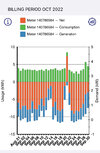@wwu123 The in/out pipes for the SuperStor can be seen to the front left of the unit in the photo.
Here's the temp close to basement ceiling for this past week. This is measured close to the boiler:

So that's the option where the boiler gets removed from potable altogether. My main concern with that is if the HPWH would not be able to keep up in extreme cold. The nice option of the oil fallback is that it uses little electricity if there's an outage allowing us to live-in comfortably for days.and I was suggesting using the HP water heater as a pre-heater
cold supply in -- HP WH -- SuperStor water tank -- faucet
Here's the temp close to basement ceiling for this past week. This is measured close to the boiler:



